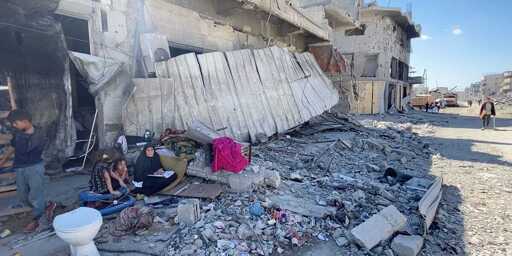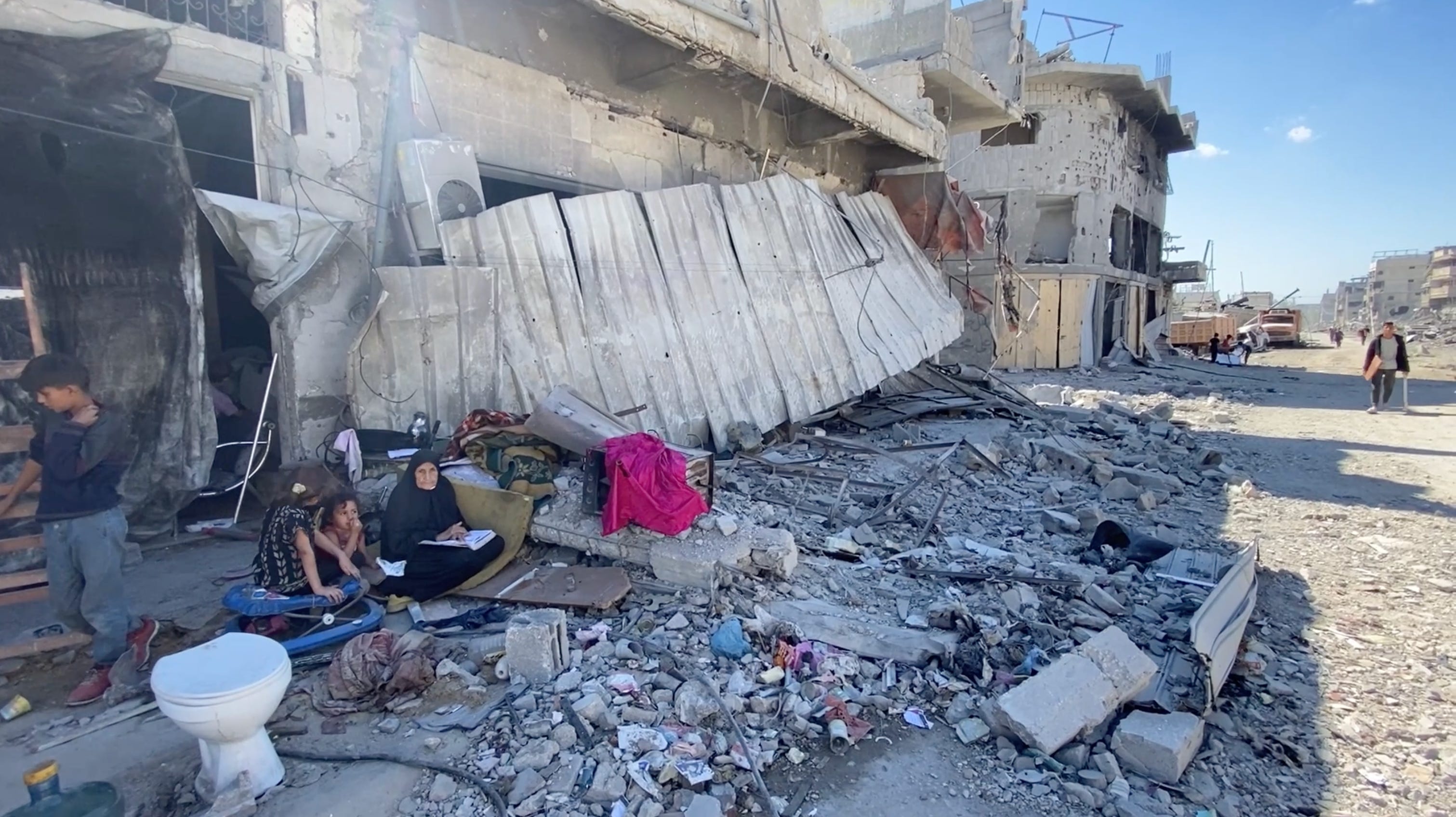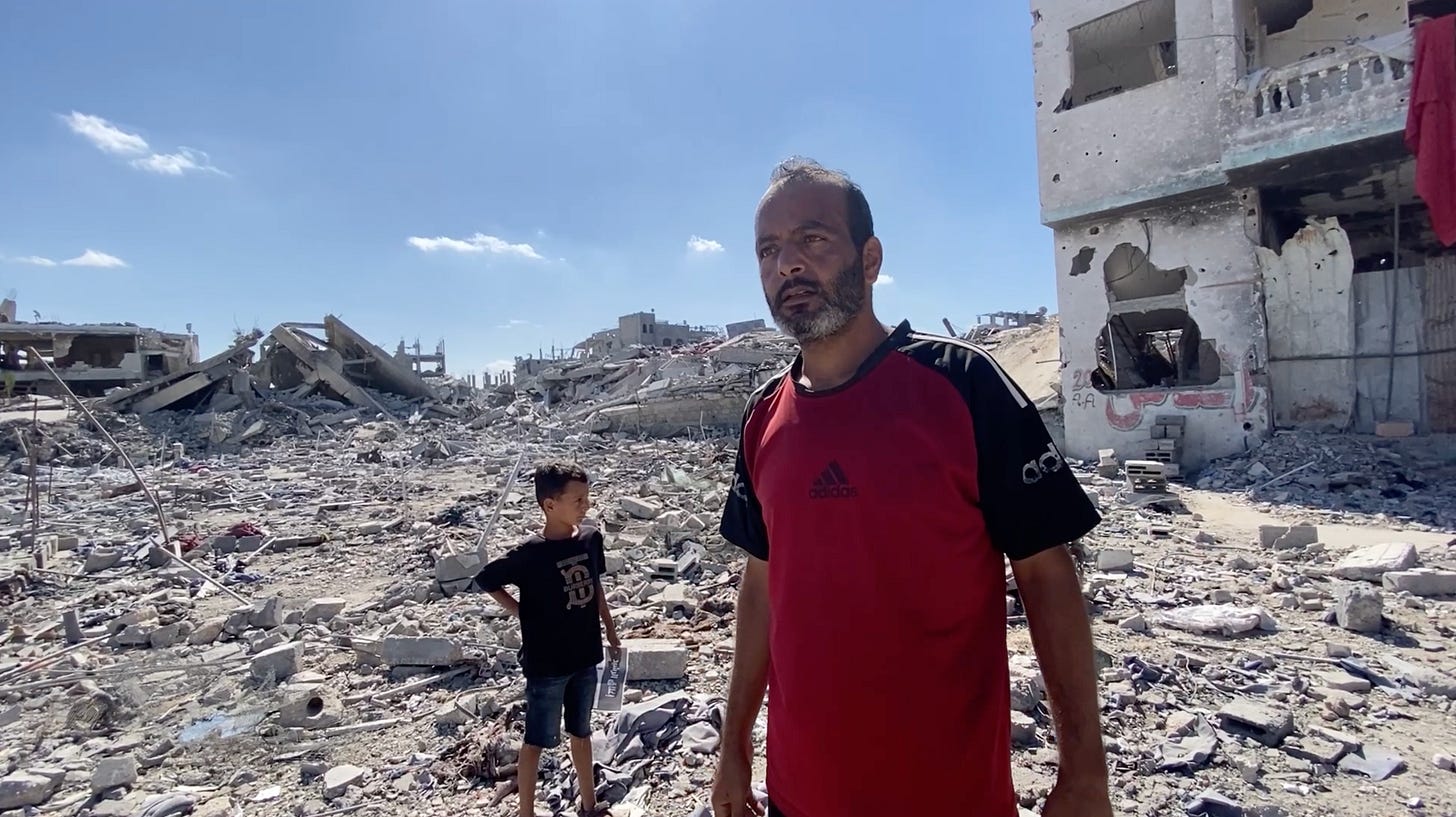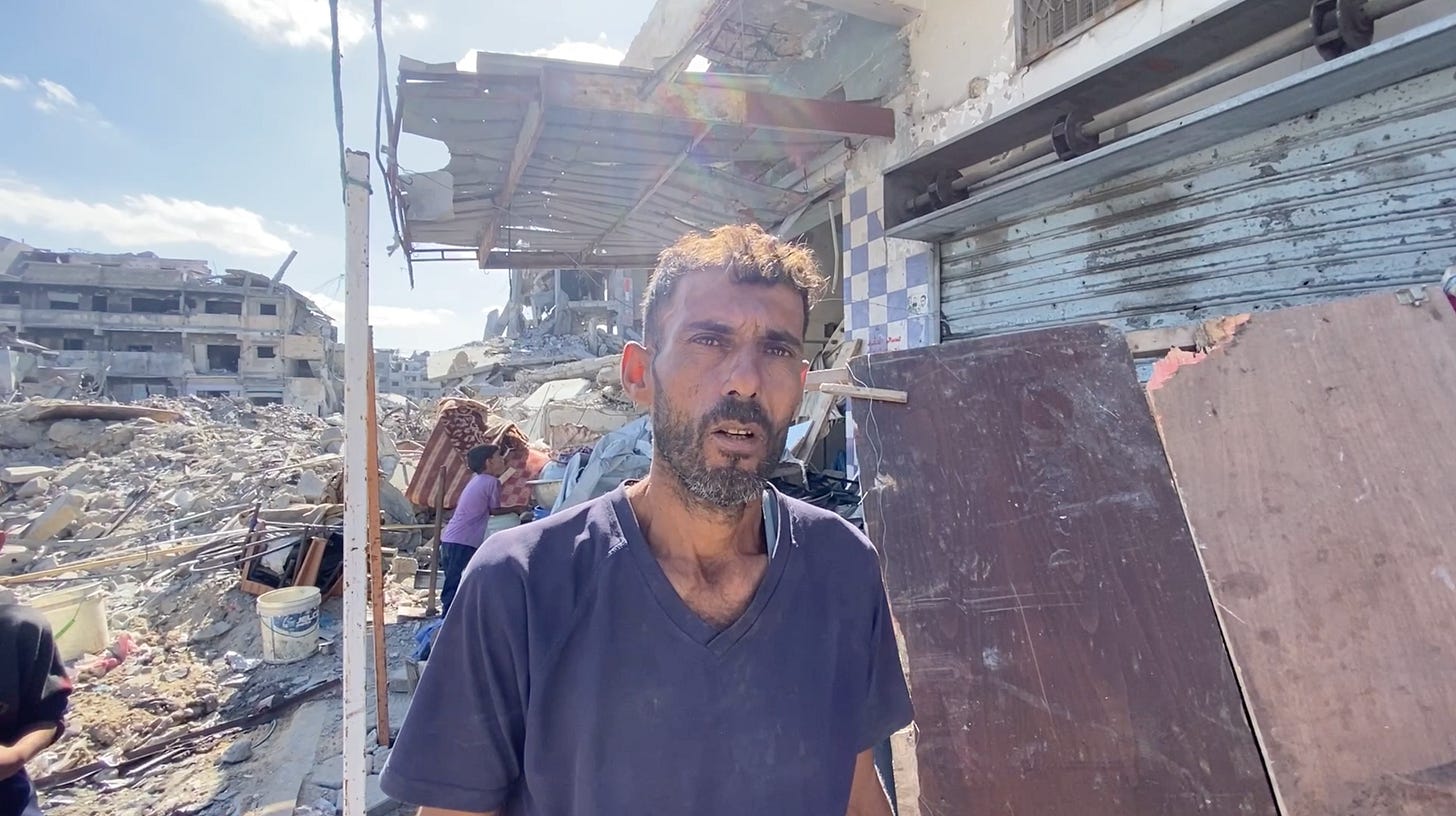We have a commitment to ensuring that our journalism is not locked behind a paywall. But the only way we can sustain this is through the voluntary support of our community of readers. If you are a free subscriber and you support our work, please consider upgrading to a paid subscription or gifting one to a friend or family member. You can also make a 501©(3) tax-deductible donation to support our work. If you do not have the means to support our work financially, you can do your part by sharing our work on social media and by forwarding this email to your network of contacts.
Hajar Al-Sawwaf sits with her grandchildren after returning to Shujaiya, Gaza City. October 15, 2025. (Screenshot of video by Abdel Qader Sabbah.)
SHUJAIYA, GAZA CITY—Hajar Al-Sawwaf sat cross-legged in front of a heavily damaged building in the eastern Gaza City neighborhood of Shujaiya amid a few torn blankets, pieces of rubble, and several of her grandchildren. Behind her, relatives were trying to close up the front of the structure with sheets of curated metal and tarp. A few people walked through desolate streets as the sounds of Israeli drones buzzed overhead.
Like thousands of others, Al-Sawwaf fled Shujaiya amid Israel’s military onslaught. Along with her family, she returned to the devastated neighborhood following the ceasefire that went into effect on Friday. She returned even though parts of Shujaiya lie inside the “yellow line,” an invisible demarcation where Israeli troops withdrew as part of the initial phase of the ceasefire agreement. “We fled with only the clothes on our backs,” she said. “And now, we’ve come back again again, and God willing, we’ll stay here. By God, we’ll die here…Everything is gone, but praise be to God, we’ve returned.”
Since the ceasefire went into effect on Friday, the Israeli military has killed at least 23 Palestinians in Gaza, at least five of them in one attack on Shujaiya on Tuesday. The Israeli military admitted to the killings, claiming a group of people approached its soldiers stationed there. That same day, the Israeli military spokesperson reiterated a warning to Palestinians not to approach certain areas in Gaza, including Shujaiya, Beit Hanoun, and Beit Lahia in the north, as well as locations in Khan Younis and Rafah in the south.
Al-Sawwaf, 78, has lived in Shujaiya ever since her family fled there during the Nakba shortly after she was born. “I got married in Shujaiya and gave birth to all my children here—14 of them,” she told Drop Site. Two of Al-Sawwaf’s children, her husband, grandson, and another relative were all killed in the war. Amid a famine and no clean water, Al-Sawwaf’s health has deteriorated. “I used to weigh 86 kilos, now I’m 60. I can’t walk, and I’m ill. I’m sick all day,” she said, breaking down in tears.
Scenes from the Gaza City neighborhood of Shujaiya on October 15, 2025. (Video by Abdel Qader Sabbah.)
Upwards of half a million Palestinians returned to the north following the ceasefire, according to Gaza’s Civil Defense, many of them to Gaza City. They returned to find much of the city in ruins. In Shujaiya—once one of the largest and most populous neighborhoods in Gaza City—every building has either been destroyed or heavily damaged. Despite the danger, a number of families have returned to the area, setting up makeshift tents on the rubble. Men, women, and children—many of them barefoot—walked the desolate streets carrying buckets, mattresses, and gas cylinders as they tried to build some sort of shelter. Clotheslines with drying laundry were strung up outside on twisted metal and broken walls. Families used shovels to clear rubble on inside the ground floors of heavily damaged buildings, moving broken concrete from one room to another to try and clear some living space.
“There are no streets, nothing left to even walk on,” said Bilal Hameed, a displaced resident of Shujaiya who returned following the ceasefire. “There’s no life left, no money left, no food. When you go to the charity kitchens, people are crowded on top of each other and you can’t even get a share.” Like the majority of Palestinians in Gaza, Hameed was displaced multiple times—to Rafah, Khan Younis, and Deir Al-Balah.
Bilal Hameed, a displaced Palestinian who returned to Shujaiya, Gaza City after the ceasefire. October 15, 2025. (Screenshot of video by Abdel Qader Sabbah.)
When asked why he risked returning to Shujaiya, which has been declared a dangerous area, Hameed responded, “Should I expose myself to danger or expose myself to humiliation, to degradation, to being insulted? No. Dead is dead—but if I must die, I’d rather die with dignity than live humiliated…I have to return to my area and stay steadfast here. To show people that I’m standing firm. No matter what they do here, we’ll return to our neighborhoods, rebuild them, and live our lives again.” He added, “My family, my land, my neighborhood—Al-Shujaiya. I’ve lived here all my life, grew up here. I’ve been here thirty‑seven years. My family’s been here for fifty, even two hundred years. Where can I go? To another area? Everyone says, ‘Each person belongs to his own neighborhood.’ So each one should live in his own place.”
Israel Katz, Israel’s defense minister, also sought to justify the killing of Palestinians in Gaza following the ceasefire. “The IDF operates in accordance with directives and enforces a clear policy of preparedness along the yellow line—which includes over 50% of Gaza’s territory,” he posted on X on Wednesday. “The enforcement policy is unequivocal: for every violation, an immediate response. Yesterday, terrorists who attempted to approach and cross were thwarted—and so it will be in the future as well,” he wrote, in reference to the killings in Shujaiya.
Much of Gaza is still in the grip of a worsening famine, with Israel restricting the number of humanitarian aid trucks admitted under the terms of the ceasefire deal and with the Rafah border crossing still closed. Along with the continued restrictions on food, fuel, and medicine, Israel is restricting the entry of heavy equipment and machinery necessary to clear tens of millions of tons of rubble, underneath which thousands of Palestinians killed in the war remain buried and missing. A United Nations Development Program representative told a press briefing this week that the amount of rubble in Gaza would stack 12 meters high in all of Central Park in New York City or be enough to build 13 giant pyramids in Egypt.
“In this area, there are no neighbors left,” Mohammad Al-Sawwaf, a displaced Palestinian who returned to Shujaiya, told Drop Site. “If you happen to find one neighbor still around, it’s like finding a treasure. The rest, as you can see, are under the rubble. No one has been pulled out yet. They’re still beneath the rubble. There are no excavators, no life. But still, we will create life, and we will live. Even if they destroy the entire world.”
Mohammad Al-Sawwaf, a displaced Palestinian who returned to Shujaiya, Gaza City after the ceasefire. October 15, 2025. (Screenshot of video by Abdel Qader Sabbah.)
As he spoke, he hauled broken cinder blocks from a pile of rubble to try and secure a piece of tarp for a shelter. “It’s like an earthquake struck this place. I don’t even know how to describe it to you. They didn’t leave anything. Even if there was shelter for a cat, a dog, or any creature, all the creatures have been wiped out. There are no birds, no animals, nothing. As you can hear, the sound of the Apache helicopters, they even violate the truce. Since this morning, they’ve been firing from the air, as if nothing has changed.”
Al-Sawwaf’s father, two brothers, and nephews, were killed in the war as they tried to flee to the south. “This area holds all our memories and our entire life,” he said. “My brothers, my father, our friends, and our families are all buried here. Even if it’s destroyed, even if it’s in ruins, we’ll sit here on top of the rubble…Even if they demolish everything over our heads, we’re staying. Where can we go?”
Sharif Abdel Kouddous and Jawa Ahmad contributed to this report.
From Drop Site News via this RSS feed





